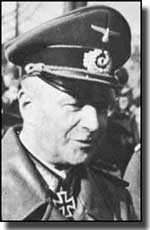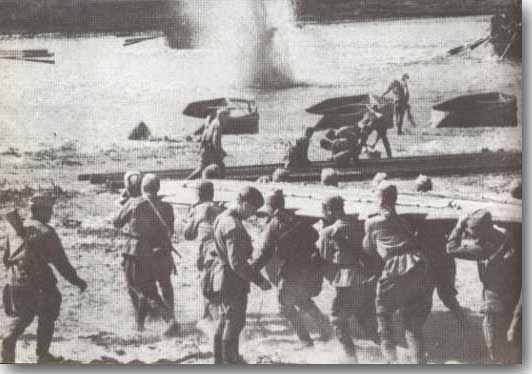Field Marshal Ernst Busch. ( 1885-1945 )
 Born in the industrial Ruhr, at Essen-Steele on the 6th. of July 1885. Busch after graduating from the Gross-Lichterfelde Cadet Academy in 1904 became an Officer Cadet in the Imperial Army, in the Westphalian 13th. Infantry Regiment. Elevated to Second Lieutenant in 1908, and by 1913 was a First lieutenant, all quite routine promotion.
Born in the industrial Ruhr, at Essen-Steele on the 6th. of July 1885. Busch after graduating from the Gross-Lichterfelde Cadet Academy in 1904 became an Officer Cadet in the Imperial Army, in the Westphalian 13th. Infantry Regiment. Elevated to Second Lieutenant in 1908, and by 1913 was a First lieutenant, all quite routine promotion.
World War 1.
Throughout WW1, Ernest Busch as an infantry commander was employed on the Western Front, he made Captain in 1915. He saw a great deal of action having fought at Reims, Namur, in Flanders, at La Basse, Arras, and Verdun, plus in 1918 in the Champagne area. He was awarded the prestigious Pour le Merite ( the Blue Max ) for displaying exceptional courage.
Post WW1.
Busch was selected to be retained in Germany's limited post WW1 army, and over the period 1919-1932 he held various staff and command jobs, including Inspector of Transport Troops in 1925.
By 1930 he had reached the rank of Colonel, and was in command of the 9th. Infantry Regiment at Potsdam.
Political bent.
Busch was a Nazi to his boot straps, a devout follower of Adolf Hitler. In 1933, Hitler assumed control, the army career of Busch then took off, Major General 1935, two years later Lieutenant General. During the crisis sparked by the Blomberg and Fritsch farce, Busch very strongly backed Hitler, and was rewarded by being promoted to a General of Infantry on the 2nd. of February 1938, he was only 53 years old.
He replaced von Kleist to become commander of Wehrkreis VIII, and was an avid supporter of Hitler's plan to invade Czechoslovakia, despite its inherent risks.
Polish Campaign.
In the blitz on Poland, the general led his V111 Corps on the left flank of List's 14th. Army to take Krakow, press on along the Vistula and wind up near Lvov.
Invasion of France.
For the Western Front campaign, Busch commanded the 16th. Army, replacing Georg von Kuechler, in the final mopping up stage in France he controlled 13 infantry divisions, and after France surrendered, he was made Colonel General on the 19th. of July 1940. He had come a long way in a relatively short period, but his fortunes were to change in Russia.
On the Russian Front.
Here in Russia, Busch was involved in the 1941/42 winter offensive, he advanced to Staraya Russa, then got into trouble when the Russian 34th. Army counterattacked, and Manstein with his LVI Panzer Corps needed to rescue him.
In January of 1942 Busch with 9 infantry divisions and two motorised divisions in temperatures as low as minus 60 degrees F, was hit by five Russian armies. He told his commanders he had no reserves, they would just have to hold on, Busch just managed to hold the vital supply base of Staraya Russa, but there was street fighting up to the 16th. Army's main depot.
Kuechler, C-in-C of Army Group North wanted to have Busch relieved of his command, but Hitler retained him. It was fortunate that the Russians now turned south to head for Vitebsk and Smolensk. Hitler now rushed reinforcements to the depleted 16th. Army.

Operation Barbarossa, Germany attacks Russia, June 1941
Promotion to Field Marshal.
As indicated, his field commander had wanted Busch relieved, but Hitler rewarded Busch by making him a Field Marshal on the 1st. of February 1943. It must have been his reward for being such a pro Nazi, rather than any prowess in the field in Russia.
Field Marshal Guenther von Kluge.
On the 28th. of October 1943, von Kluge was involved in a car accident, and was very seriously injured, the following day Hitler named Ernest Busch as C-in-C Army Group Centre to take over from von Kluge. A grievous mistake on Hitler's part, as we shall soon discover.
Army Group Centre.
In May of 1944, the German Army of 2.24 million faced 6.07 million Russians on the Eastern Front, all initiative by the German command lost. The Russian airforce held total superiority, especially over Army Group Centre, which had both its flanks exposed, it was still some 290 miles from Moscow, and Berlin lay 550 miles in its rear. Model in charge of Group North Ukraine, convinced Hitler to give him LVI Panzer Corps from Busch's command, and off they went.
Stalin reinforced his troops opposing Army Group Centre, and by the 21st. of JuneBusch with 700,000 troops was facing 2,500,000 Russians, he was in dire trouble, he had visited Headquarters mid May, trying to convince Hitler to allow him to withdraw to the Dnieper or the Beresina, both rivers to the west. Hitler would not hear of it, rejecting such appeals.
Stalin waited till the Allies had landed in Normandy, and Germany was then totally involved on two fronts, on the 22nd. of June 1944, the Russians struck.

Soviet troops attempt to cross the Dneiper River under heavy German fire, July 1944
Army Group Centre Destroyed.
Firstly they laid down an incredible aerial and artillery bombardment, and thenattacked across a 300 mile front. Stalin sent in 200 divisions, 6,000 tanks and assault guns, all backed up with 7,000 aircraft, this time he really meant business.
The commander of the German 4th, Army wanted to retreat behind some shelter from the Dneiper River, but Busch refused to consider it. He blindly obeyed Hitler and in the process lost 300,000 men, 215 tanks and about 1,500 guns. The worst defeat on the Eastern Front, worse even than at Stalingrad. Hitler sacked Busch on the 28th. of June, replacing him with Model.
Before Model could stop the Russian onslought they had pushed back the German line 435 miles, and were threatening the very Reich borders.

German POW's Russia July 1944
Busch Fades Out of the Picture.
The Field Marshal faded out of the scene for some time, now Guderian spoke to Hitler on his behalf, and he was allowed to present the oration at the funeral of Hitler's chief adjutant, General Rudolf Schmundt, who had died from his wounds received in the 20th. of July assassination attempt on Hitler.
Busch gradually worked himself back into favour, until on the 20th. of March 1945 he was nominated C-in-C, OB Northwest.
The Last Hurrah.
Busch actually only had a single battlegroup, some impressed labour battalions, and a few Hitler youth units. His task, to guard the North Sea coast, Schleswig-Holstein, and part of Eastern Holland. The Western Front was crumbling, he faced Field Marshal Montgomery, and his final act as a serving soldier was to sign the German surrender on the 4th. of May 1945.
The war in Europe was finally over.

Field Marshal Bernard Mongomery, fought against Busch,
who signed the German surrender on the 4th. of May 1945
Captivity.
Busch was taken to England, totally a broken man, he died in captivity on the 17th. of July 1945. His body buried at Aldershot, on waste ground, in an unmarked grave, and a false death certificate was used.
Conclusion.
Busch had fought bravely in WW1, he gained promotion by dint of his strong embracement of both Hitler and the Nazi regime. His promotion to Field Marshal probably placed him well above his level of competence.
He will long be remembered as the Army Group Commander who lost the most troops on the Russian front, an appaling figure of 300,000 soldiers.
Came to a sad end in a foreign land.
It is indeed a truism " To the Victors, go the Spoils."
return to index of "Adolf Hitler and his WW2 Field Marshals"





